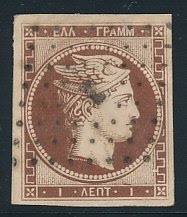
There is no more appropriate stamp design than the portrait of Hermes, the messenger god in his winged helmet, on the first stamps of Greece. Hermes, son of Zeus, was also the god of commerce so it is not only as a messenger that he is pictured on the first stamp but as the facilitator of commerce which was the major economic benefit of the first postal issues. The Hermes Heads stamps of Greece are among the most difficult in philately to identify, not because the stamps are any more intrinsically difficult than any others, but because the catalog listings are overly complex and specialized to an almost absurd degree.
The Scott catalog, following the Greek catalogs, make 58 major numbers and hundreds of minor ones out of the same stamp design. These stamps were printed from the same plates and the distinguishing characteristics are often such qualities as where the stamps were printed (Paris prints), who did the printing (Belgian workmen) and whether the plates were wiped clean or not before new ink was applied. One does not have to be a philatelic philistine to think this a bit excessive and the effect has been to make these beautiful stamps less popular than they would otherwise be. ( The same effect can be seen on the US Banknote issues (Scott 134-191) where the same plates were used for four different Scott listed sets-these stamps have always been among the least popular US issues because they are overly complex). Further complicating the situation, most of the Hermes Heads have back prints (of the denomination of the stamp) which were an anticounterfeiting and accounting devise and which provide numerous additional varieties.
If you are looking for an interesting and complex specialty, you could do worse than these stamps. But be warned- it is a field where disputes are common. There is an old philatelic joke about the five Greek experts who identified a Hermes Head. They came back with six opinions.
